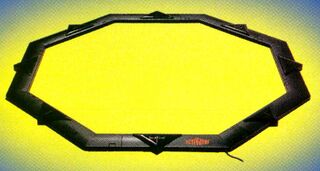Difference between revisions of "Activator"
From Sega Retro
AllisonKidd (talk | contribs) |
|||
| Line 20: | Line 20: | ||
<gallery> | <gallery> | ||
File:Activator MD US PrintAdvert.jpg|US print advert | File:Activator MD US PrintAdvert.jpg|US print advert | ||
| + | TeamPlayer-MegaMouse-Activator MD US PrintAdvert.jpg|US print advert 2 | ||
File:Activator_MD_BR_PrintAdvert.jpg|BR print advert | File:Activator_MD_BR_PrintAdvert.jpg|BR print advert | ||
</gallery> | </gallery> | ||
Revision as of 07:21, 16 February 2015

| |||||
| Activator | |||||
|---|---|---|---|---|---|
| Made for: Sega Mega Drive | |||||
| Manufacturer: Interactive Light | |||||
|
The Activator is a video game controller released for the Sega Mega Drive during the mid-1990s. It is an octagonal controller which sits on the floor and uses infra-red beams to interpret movements, acting as supposedly more immersive substitute for a standard control pad.
The Activator was created at a time where many video game companies were investing in virtual reality, perceived at the time to be the future of gaming, however for the most part, virtual reality was considered to be too expensive to produce at the time, so products such as the Activiator were produced instead. The Activator was developed by Interactive Light for Sega of America, though was also brought to Brazil by Tec Toy. It was based on a musical instrument called the "Light Harp", conceived by musician and martial artist Asaf Gurner.
The Activator comes in eight segments, which when fitted together creates an octagonal ring which is designed to be placed on a floor. Each section of the Activator fires a beam of light upwards, and the player stands inside the octagon, "punching" and "kicking" to break the light beams and sending signals to the Mega Drive console in the process. The Activator is effectively a glorified control pad, with ![]() ,
, ![]() ,
, ![]() ,
, ![]() ,
, ![]() ,
, ![]() ,
, ![]() and START buttons mapped to each of the eight segments.
and START buttons mapped to each of the eight segments.
Sega of America marketed the Activator as a martial arts simulator, claiming that it improved the experience of fighting games such as Eternal Champions (one of the few games designed around the peripheral). In reality, the reverse was true - many games such as Mortal Kombat and Comix Zone are considered to be more difficult to play with an Activator, and many games which rely on fast reactions are not suitable for this style of control scheme at all. Furthermore the light beams are easily distorted by a non-flat ceiling or obstructions such as beams of a ceiling fan or light fixture. As a result, the Activator did not see much commercial success and was retired mere months after launch.
Promotional Material
- Activator MD US PrintAdvert.jpg
US print advert
- TeamPlayer-MegaMouse-Activator MD US PrintAdvert.jpg
US print advert 2
Physical Scans
External links
- Sega Activator Ring Instructional Video
- Sega Activator Demonstration at 1993 Winter CES
- U.S. Patent 5,045,687



